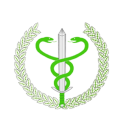BIOLOGICAL HAZARDS
1. What is a biological hazard?
Biological hazard are biological agents which present a threat to human or animal health or life, and include microorganisms: bacteria, viruses, fungi or parasites and the products of their metabolism.
2. What are harmful biological agents?
Harmful biological agents are all microorganisms (viruses, bacteria, fungi, parasites) or toxins (toxic chemical substances produced by biological organisms) which may have negative impact on living organisms and consequently endanger their health or life.
Harmful biological agents can cause infection, allergy and poisoning.
They include:
- cellular microorganisms, including those genetically modied
- non-cellular entities capable of replicating or transferring genetic material, including those genetically modied
- cell cultures
- human endoparasites
that may lead to:
- infection
- allergies
- poisoning
3. Classification of harmful biological agents
Depending on the level of pathogenicity, biological agents have been classfied into 4 hazard groups. Criteria for classification of the agents into respective groups are as follows:
- the ability to cause disease in people and the severity of its course
- the capacity and rate of spread of the disease in the population
- the possibility to apply eective preventive and treatment measures
4. Groups of biological hazards
Group 1
– agents which are unlikely to cause disease in people.
Agents in this group pose virtually no hazard and are therefore not included in the list of harmful biological agents. When working with agents belonging to hazard group 1, following general hygiene rules laid down in the legislation in force is sufficient to eliminate exposure or reduce the degree of this exposure.
Examples of such agents are the following allergens:
- nuts
- blue cheese
- soya
Group 2
– agents which may cause disease in people but are unlikely to spread in the human population.
There are usually effective methods of prevention or treatment, e.g in the following cases:
- Staphylococcus aureus
- Clostridium tetani (tetanus)
- Aspergillus fumigatus (fungal infection)
Group 3
– agents which may cause severe disease in people and which are very likely to spread in the human population.
Eective prevention or treatment methods usually exist, e.g. for:
- Yersinia pestis (plague)
- Mycobacterium tuberculosis (tuberculosis, TB)
- Blastomyces dermatitidis (Blastomycosis, Gilchrist’s disease)
- Yellow fever virus (yellow fever)
– biological agents which present a limited risk of infection to people as they are not usually transmitted by airborne route, e.g.:
- Salmonella typhi (typhoid fever)
- Shigiella dysenteriae Type 1 (dysentery)
- HIV, HBV, HCV
- Rabies virus
- Agents of spongiform encephalopathies (BSE, CJD)
Group 4
– agents which may cause severe disease in people and have a high probability of spreading to the human population
There are usually no eective methods of prevention or treatment for them, e.g.:
- Ebola virus
- Lassa virus
- Smallpox virus
According to the criteria outlined above, biological hazards are divided into four classes:
virtually no hazard
moderate hazard
serious hazard
very serious hazard
5. What is a biological incident?
A biological incident is any action or emergency that poses a risk of spreading harmful biological agents.
6. What services act in a biological emergency situation?
Police – securing the hazard zone

State Fire Service – Specialized Chemical and Ecological Rescue Groups (SGRChem) having appropriate training and equipment

State Sanitary Inspectorate – epidemiological investigation

Veterinary Inspection – epizootic investigation (particularly important in terms of zoonoses and zoonotic agents)
7. What is decontamination?
Decontamination is the process of removing and/or deactivating a harmful substance, e.g. a harmful biological agent, which endangers the life or health of a living organism through direct contact or through the use of equipment. Decontamination may involve people, animals and the inanimate environment (infrastructure, equipment, facilities, etc.).
The identification and designation of the site for decontamination, following exposure to pathogens of biological hazard groups 3 or 4, is determined by the State Sanitary Inspectorate in agreement with the commander of the Specialized Chemical and Ecological Rescue Group (SGRChem) responsible for actions taken by the State Fire Service. The State Sanitary Inspectorate supervises the process of preparing the site for decontamination.
8. What is bioterrorism?
Bioterrorism – a type of terrorism defined as the unlawful, illegal use of biological agents against people with the intent to coerce or intimidate a government, civilian population, or any part of it, to achieve personal, political, social or religious goals. The agents of aggression are microorganisms (bacteria, viruses, fungi), toxins produced by certain microorganisms, and plant poisons. Often these agents are further modified to pose an even greater threat to human and animal health and life, as well as to the environment.
Pathogenic microorganisms can be carried by missiles, aerial bombs, containers or mail. The spread of harmful biological substances is also facilitated by previously infected natural hosts such as insects – fleas, bedbugs, body lice living in clothes, flies, mosquitoes or arachnids – ticks. They can transmit microorganisms directly to people, water or food. Asymptomatic carriers of a given infectious disease are able to travel easily over long distances.
9. How to proceed if you receive a consignment suspected of being contaminated with biological substances?
A suspicious consignment means:
- unexpected consignment or received from unknown sender
- no sender or no sender’s address on the consignment
- consignment from a suspicious sender
- wrong address
- consignment unusual in terms of weight, dimensions, shape, smell, etc.
If you receive a suspicious consignment:
- do not open the consignment
- place the consignment in a thick plastic bag, close the bag tightly
- place the consignment in another thick plastic bag, close the bag tightly,
- tie it into a knot and seal with adhesive tape
- do not move the package, leave it in place
If a suspicious consignment has been opened and contains any suspicious solid (dust, chunks, block, jelly, foam or other) or liquid contents, the following steps shall be undertaken:
- keep contents undisturbed: do not spill, carry, touch, smell or move them, do not cause air movement in the room (turn o ventilation and air conditioning systems, close windows)
- if possible, put on gloves
- put the entire contents in a plastic bag, close it tightly and seal it with tape or plaster
- wash hands thoroughly
- place the sealed bag in another bag, close and seal it
- wash hands thoroughly again
- in the absence of suitable packaging, avoid moving or handling the consignment
If such situation occurs, notify the following:
- Police – phone no. 112 or 997
- State Fire Service – phone no. 112 or 998
- Crisis Management Centre (voivodship, municipal, poviat)
- Head of the organizational unit if the situation concerns the workplace
UPON THE ARRIVAL OF THE COMPETENT
SERVICES, ALWAYS FOLLOW THEIR INSTRUCTIONS
Actions to be taken by the head of the organisational unit:
The head of the organizational unit, upon being informed of the receipt of a suspicious package, is obliged to:
- make sure that the competent services have been informed of the incident
- make sure that the suspicious consignment and the consignments that have come into contact with it are separated from other documents and limit the area (space) adjacent to it
- put all the objects that may have come into contact with the suspicious consignment in a plastic bag and keep them there until handed over to the competent services
- make sure that all persons who might have come into contact with the suspicious consignment have washed their hands with soap and water (if conditions allow, instruct them to take a shower (soap and water)) and do it yourself
- make a list of persons who might have come into contact with the suspicio us consignment – forward the list to the medical-sanitary services
- assess the degree of risk and notify the relevant crisis management centre
Upon the arrival of the police intervention group, the head of the organisational unit provides its commander with all information concerning the incident.
10. The principles of alerting in case of a biological hazard situation
The alarm signal in the event of an emergency may be transmitted by telephone, sirens, mobile loudspeakers or an internal warning system, e.g. OC alarm system, radio and television, car radio, etc.
State of emergency
Attack previously announced
Measures:
- switch on radio and TV sets to local programme to listen to warning messages, follow instructions of announcements broadcast by civil defence
- alert and evacuate people in the area at risk of biological contamination (e.g. employees, customers, business people, pupils, students, visitors)
- switch off air conditioning equipment in the facility, immediately close and seal all ventilation ducts, windows and doors
- prepare moist cotton pads for respiratory protection, in case of penetration of the biological agent into the interior of the premises – frequent change of the moist cotton pad or moistening it with water maintains the absorption capacity at a constant level
- as far as possible gather handy emergency supplies and antidotes: dust masks, gauze, cotton wool, acetic acid, lemon juice, edible oil, water, hydrogen peroxide, soap, paraffin oil, circulatory stimulants, spirits for washing the skin
- refrain from eating, smoking and work that requires a lot of effort
- depending on the circumstances and needs to notify the Police, the State Fire Service, the Emergency Medical Service
- until the alarm is cancelled or evacuation is ordered, it is not allowed to leave sealed rooms, stay near windows and other ventilation openings
- persons in the open or proceeding to evacuation (after it is ordered) should as soon as possible leave the danger zone perpendicular to the direction of the wind carrying contaminated air
Alarm announcement after the announcement of an attack with biological agents
Attack immediately detected
In addition to the actions described above:
- use passive protective measures – masks, protective clothing, evacuation of people from the endangered facilities, protecting facilities
- evacuate people from the contaminated rooms, area
- limit or prohibit the movement of people outside the building (except for the release of employees to go home)
- carry out preventive measures among the employees and students exposed to danger
- use preventive antibiotics for people sent to the contaminated area
- carry out sanitary and special procedures (e.g. decontamination of people, clothing and equipment in the contaminated area)
- follow radio and other announcements, follow the instructions of the management of the University and managers of emergency units
Attack detected late (suspected outbreaks have already occurred)
Measures:
- maintaining a cordon sanitaire and separating contaminated (infected) zones
- placing people and, in some cases also animals, in these zones in quarantine
- decontamination of people, clothing and equipment in the contaminated zone
- hospitalization of patients with clinical symptoms
- providing the population with safe food and water and clean clothing
- taking preventive measures in non-contaminated zones
Alarm cancellation
Once the biological contagion alarm has been cancelled, the following steps should be undertaken:
- remove the biological agent threat inside the building through special decontamination procedures
- thoroughly ventilate all premises
- provide evacuated victims with emergency assistance
- remove contaminated materials (non-relevant agents, objects – property)
- carry out a specialized health and safety at work inspection; regular work can start after the causes of hazard are removed
